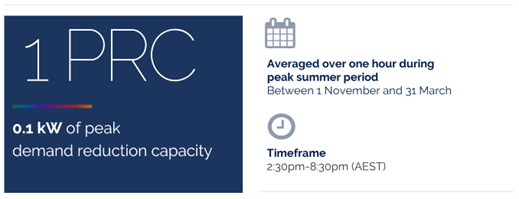Peak Reduction Certificates
A Peak Reduction Certificate (PRC) is a tradeable certificate. It represents 0.1 kilowatts of peak demand reduction capacity averaged over one hour during the peak summer period. This occurs between:
- 1 November and 31 March
-
2:30 pm and 8:30 pm Australian Eastern Standard Time, which is equivalent to 3:30 pm to 9:30 pm Australian Eastern Daylight Time.

ACPs create certificates from activities that provide capacity to reduce electricity use during these peak demand periods.
Capacity Holder and nomination
Under the scheme rules, only an ACP can create PRCs from an activity that reduces peak demand for electricity. However the ACP must be nominated as the capacity holder before they can create certificates.
Householders and businesses that undertake the activity are the original Capacity Holder. However, they can make an ACP the Capacity Holder in their place by completing a nomination form.
To be eligible to create a PRC, the ACP must be the Capacity Holder on or before the date the activity is implemented.
More information on nomination is provided on our Working with third parties page.
Creating certificates
The ACP must register certificates in the Registry of Certificates before they are valid.
PRCs have a vintage, status and expiry date. See our PRC vintage and forward creation, PRC status and PRC expiry pages for more details.
Selling certificates
Registered PRCs can be sold to scheme participants (mainly energy retailers) or other parties. Scheme participants use certificates to meet their obligations under the PDRS.
More information is available on the Trading certificates page.
